African crop yield reductions due to increasingly unbalanced Nitrogen and Phosphorus consumption
Abstract
The impact of soil nutrient depletion on crop production has been known for decades, but robust assessments of the impact of increasingly unbalanced nitrogen (N) and phosphorus (P) application rates on crop production are lacking. Here, we use crop response functions based on 741 FAO maize crop trials and EPIC crop modeling across Africa to examine maize yield deficits resulting from unbalanced N : P applications under low, medium, and high input scenarios, for past (1975), current, and future N : P mass ratios of respectively, 1 : 0.29, 1 : 0.15, and 1 : 0.05. At low N inputs (10 kg ha−1), current yield deficits amount to 10% but will increase up to 27% under the assumed future N : P ratio, while at medium N inputs (50 kg N ha−1), future yield losses could amount to over 40%. The EPIC crop model was then used to simulate maize yields across Africa. The model results showed relative median future yield reductions at low N inputs of 40%, and 50% at medium and high inputs, albeit with large spatial variability. Dominant low-quality soils such as Ferralsols, which are strongly adsorbing P, and Arenosols with a low nutrient retention capacity, are associated with a strong yield decline, although Arenosols show very variable crop yield losses at low inputs. Optimal N : P ratios, i.e. those where the lowest amount of applied P produces the highest yield (given N input) where calculated with EPIC to be as low as 1 : 0.5. Finally, we estimated the additional P required given current N inputs, and given N inputs that would allow Africa to close yield gaps (ca. 70%). At current N inputs, P consumption would have to increase 2.3-fold to be optimal, and to increase 11.7-fold to close yield gaps. The P demand to overcome these yield deficits would provide a significant additional pressure on current global extraction of P resources.
Introduction
Agricultural consumption of nutrients is unequally distributed among the world's nations (Vitousek et al., 2009). In industrialized countries, an oversupply of fertilizers has led to detrimental environmental consequences for water quality and biodiversity, and attendant financial losses, estimated at between €70 (ca. 100 US$) and €320 × 109 in Europe (Sutton et al., 2011). Increasingly, precision farming practices and optimal nutrient supply are promoted to bring these agricultural systems onto a pathway of sustainable intensification while maintaining high yields. In contrast, crop yields in the developing world, especially in Africa, are still very low and suffer from a shortage of nutrients (Sánchez, 2010). Current fertilizer and manure additions continue to be below crop requirements in many smallholders' fields resulting in maize yields below 1 ton ha−1 across large parts of Africa. In contrast, average yields in Europe are ca. 8 ton ha−1. Production ecological models indicate that current cereal production in sub-Saharan Africa reaches only 15–30% of its biophysical maximum (Bindraban et al., 2012; Folberth et al., 2013). Replenishing soil fertility in Africa is the primary biophysical requirement to enable improved crop varieties and policies to improve food security (Sánchez, 2010; Mueller et al., 2012; Van der Velde et al., 2013).
Globally, there has been a dramatic shift in the consumption ratio of the primary crop nutrients; see e.g., (Peñuelas et al., 2012, 2013). This is mostly due to increased consumption of nitrogen (N), not being matched by similar increases in consumption of phosphorus (P) and potassium (K). In Africa, total N consumption increased by 120% between 1975 and 2005–2796 × 103 tons in 2005; while total phosphate consumption only increased by 16% to 958 × 102 tons in 2005. Thus, in Africa, the ratio of the consumption of N and P (the N : P ratio) has risen from 1 : 0.29 (or 1 : 0.66 for N:P2O5) in 1975 to 1 : 0.15 (1 : 0.34 for N:P2O5) in 2005 (IFA data (IFA, 2013); Fig. 1). Given the increase in the total arable land area in this period (e.g., total cereal harvested area in Southern, Eastern, Western and Central Africa increased from 4.8 to 9.0 × 107 ha from 1975 to 2011, FAO data), absolute field application rates of both N and P per unit area must therefore have decreased.
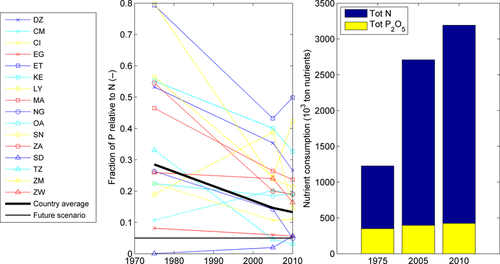
The consequence of these changes is an increasing imbalance in the N and P available for crops. The share of fertilizers containing only N (e.g., Urea), i.e. so-called ‘straight’ applications, is going up. In Africa, the relative consumption of N-urea increased from 25% of total N in 1975 to 49% in 2005, albeit with large variations among countries (IFA data). This situation is contrasting sharply with many intensive cropping systems in the industrialized world where both N and P are oversupplied, or where soil P capital has been built up over time (Sattari et al., 2012).
The supply and availability of N and P in arable soils are governed by different (biogeochemical) processes. In most soils, there is no mineral-bound pool of weatherable N, but N2 can be fixed from the atmosphere biologically; in croplands this occurs mostly through a symbiosis between legumes and Rhizobia bacteria (Robertson & Vitousek, 2009). Under natural conditions, the different soil N pools are in dynamic equilibrium as mineral N released from decomposing organic matter is taken up by plants and subsequently incorporated into living biomass, which later returns to the soil as plant litter (Robertson & Vitousek, 2009). The removal of N during crop harvest therefore necessitates organic or synthetic N addition. The amount of P in soil solution – easily available to crops – is generally very small. Most P in the soil occurs in more or less accessible (‘active’) or inaccessible (‘fixed’) solid forms and P availability for crop plants is directly governed by pH and water content. A large area of soils in sub-Saharan Africa are highly weathered with low levels of soil fertility, and notoriously low levels of available P mirrored by high P-fixing capacities (Buresh & Smithson, 1997).
In a previous study, we used 741 crop trials in Africa and South America to calculate the degree to which P limits the yield of maize (Van der Velde et al., 2013). In 76% of the crop trials, the response of maize yield to P additions was positive, and stronger than the response to N additions. The addition of small amounts (10 kg ha−1) of N alone resulted in mean yield increases of 8%. The addition of P alone (10 kg ha−1) increased mean yields by 26% (Van der Velde et al., 2013).
Since the discovery and industrialization of the Haber-Bosch process, N fertilizer can be produced without limits from atmospheric N2, albeit at a fossil fuel cost. In contrast to the nitrogen cycle, the phosphorus cycle has no gaseous atmospheric component. In addition, P mined from phosphate rock is a finite fossil resource with deposits occurring in a few countries (Cordell et al., 2009; Obersteiner et al., 2013). These dynamics have governed the increasing imbalance in N and P, which will likely worsen over time (e.g., the 2010 N : P consumption ratio in Africa equaled 1 : 0.13, and has thus already increased from the ratio of 1 : 0.15 in 2005; IFA data). African crop production is primarily limited by the amount and spatial and temporal distribution of precipitation (Challinor et al., 2007), and nutrient availability depends on available soil moisture (e.g., Harmsen, 2000), but even when sufficient water is available large extents of cropland area have become nutrient-limited because of continuing soil nutrient export through harvesting without replenishment (Stoorvogel et al., 1993; Folberth et al., 2012). To what extent the increasing imbalance in N and P will impact crop yields, both at low and high overall inputs, has not yet been examined in detail.
The requirement for proteins (N) and for nucleic acids, membranes and metabolism (P) governs the stoichiometric relationship between N and P in plant leaves. Ecological studies have observed that the N : P ratio of foliage correlates negatively with net photosynthetic rate (Reich et al., 2009), plant growth (Elser et al., 2010), and biomass production (Güsewell, 2004). Greenwood et al. (2008) found that the N : P ratios in the growth-related tissues of many crops are about 11.83 by mass, similar to the leaves of many naturally grown species. They also found that the N : P ratio of storage-related tissues was 5.8. These N : P ratios remained approximately constant during growth. Leaf N : P ratios above 16 generally suggest P-limited growth, while N : P ratios below 13.5 suggest N-limited growth (White & Hammond, 2008). In practice, fertilizer recommendations in guides are often blanket recommendations. For instance, for maize in Zimbabwe, an FAO report recommended 67 kg N ha−1 and 13 kg P ha−1 (FAO, 2006), while 92 kg N ha−1 and 17.5 kg P ha−1 were recommended in Malawi (Conroy & Kumwenda, 1995). Of course, to be effective these fertilizer recommendations should ideally be based on local soil testing, as compound fertilizers can often be obtained that are designed for specific soil and crop requirements.
In this study, we examine the impact of the increasingly unbalanced applications of N and P on maize yields across Africa. The methods used are analysis of experimental crop trial data and crop modeling. We quantify the impact of increasing N : P ratios in fertilizer applications for scenarios that reflect the past (1975), the current period (2005), and the future. We evaluate the effect on yield deficits, and investigate the relative importance of the impact under low application rates, with special significance for smallholders, as well as under medium and high nutrient application rates. We further quantify the expected yield losses for different soil types used for maize cultivation, due to insufficient P in fertilizers. Finally, we calculate optimal application rates of N and P across Africa that would maximize yields. We end with the reasons for one-sided N applications, highlighting the continuing and urgent need to both increase and balance nutrient applications in Africa, and discuss projected potential yield losses in the context of expected impacts of climate change.
Material and methods
Analysis
We assess the impact of increasingly unbalanced nutrient applications on maize yield in Africa for three scenarios that follow the observed N : P consumption ratios for the 1970s (1975, 1 : 0.29; S1), the 2000s (2005, 1 : 0.15; S2) and a possible future case of extreme imbalance (ca. 2075, 1 : 0.05; S3) under low (10 kg N ha−1; L), medium (50 kg N ha−1; M), and high (100 kg N ha−1; H) nitrogen fertilization strategies. The impact on yield is estimated using (i) analytically derived response functions from agronomic trials and (ii) crop growth modeling with the EPIC crop model (Williams et al., 1989). Associated P application rates for the past, current, and possible future scenarios at the low, medium, and high N inputs are shown in Table 1.
| N-application rate (kg ha−1) | Past (1975) N : P (1 : 0.29) | Current (2005) N : P (1 : 0.15) | Future (2050) N : P (1 : 0.05) | |
|---|---|---|---|---|
| Low input | 10 | 2.9 | 1.5 | 0.5 |
| Medium input | 50 | 14.5 | 7.5 | 2.5 |
| High input | 100 | 29 | 15 | 5 |
Assuming continental-scale uniform N : P ratios at low, medium, and high input levels of N necessarily simplifies the reality in the field. The ratios and applied amounts of nutrients will have changed over time and space. The impact of altered balances of N and P also depends on soil type, climate, and crop management. However, our simple approach will nevertheless help characterize the potential effect of the imbalance of N and P for smallholders, as well as for managers of more intensive farms. In fact, higher N : P consumption ratios, i.e. above 1 : 0.05 used here as indicative of the future, will be and already have been a reality for many smallholders over an extended period of time. The ‘future’ scenario is thus representative of the situation currently experienced by many low input farmers in Africa. Importantly, determining these spatial nutrient limitations is an essential step toward targeting improved nutrient use efficiency.
Crop response functions
Location-specific relationships between soil productivity, N and P fertilizer inputs, and corn yields, were established based on FAO crop fertilizer trials (http://www.fao.org/ag/agl/agll/nrdb/). The purpose behind the original FAO programme was to undertake a set of trials to determine suitable fertilizer application rates for locally grown crops and to demonstrate to as many farmers as possible, the positive effect of fertilizer application on crop yields and farm income (FAO, IFA, 2000). The trials were carried out from 1969 until 1993 and differed in their design as well as the time periods when they were carried out. The information available from the trials includes crop yields (kg ha−1), and application rates of the main nutrients (N, P2O5, and K2O) in different inorganic forms and from farm yard manure (kg ha−1) resulting in inputs across all trials ranging from 0 to 300 kg N ha−1 and 0 to 250 kg P ha−1. Mitscherlich-Baule crop response functions (see Frank et al., 1990; and Harmsen, 2000) were fitted through the experimental data for 741 locations in Africa (Fig. 2), having at least 5 N and P input combinations to predict corn yields (the relation between experimental and modeled yields is R2 = 0.94, P < 0.0001; see (Van der Velde et al., 2013).
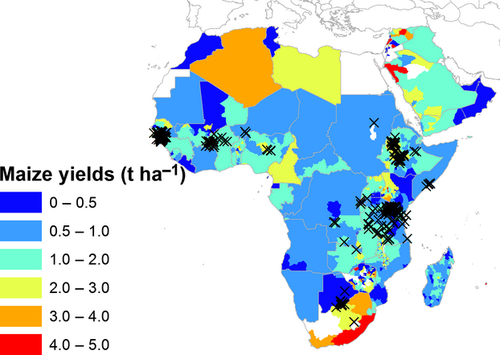
Calculation of these analytical data-driven response functions fitting the crop trial data allowed us to deduce realistic yield gaps and attainable crop production levels. The Mitscherlich-Baule crop response function was used to analyze the relations between N and P fertilizer inputs and corn yields:
 (1)
(1)The function allows for growth that levels off at higher fertilizer applications, and theoretically allows for zero substitution of N and P, as well as near perfect substitution (Frank et al., 1990). The growth plateau is represented by a1, which was set equal to the maximum yield obtained in each field trial, while a3 and a5 represent the residual available N and P in the soil. The coefficients a2 and a4 describe the influence of the corresponding N or P fertilization on yield. Application rates of farm yard manure were converted to N, P, and K application rates (Van Averbeke & Yoganathan, 1997). The parameters a2, a3, a4, and a5 were obtained by minimizing the sum of squared errors for all applications in each experiment. The Nelder-Mead multidimensional unconstrained nonlinear minimization algorithm was used to minimize the objective function. Resulting parameter values for a2, a3, a4, and a5 had median values of, respectively, 0.0160 ton kg−1, 69 kg N ha−1, 0.378 ton kg−1, and 2.9 kg P ha−1 comparable to values obtained by (Frank et al., 1990) and (Finger & Hediger, 2008) who have also used the Mitscherlich-Baule function, also see (Van der Velde et al., 2013).
EPIC crop model simulations
A GIS-based implementation of the EPIC crop model (Williams et al., 1989; Liu, 2009) has been adapted for use in sub-Saharan Africa using improved data on soil nutrient status, crop varieties and planting dates (Folberth et al., 2012), currently often missing from other large-scale crop model simulations over Africa. Importantly, this version of the EPIC crop model has been evaluated satisfactorily against African crop yield data with R2 = 0.64 (P = 0.00002; n, number of countries = 21) and y = 0.72x + 0.46 between reported and simulated crop yields (Folberth et al., 2012). The model was run at a spatial resolution of 0.5° × 0.5° using daily gridded climate data (minimum temperature, maximum temperature, solar radiation, precipitation) from the SLATE database (IFPRI HarvestChoice Labs, 2011) for the years 1970–2009. Soil data were obtained from the ISRIC-WISE database (Batjes, 2006), and crop-specific land-use data providing actual cropland area were obtained from the MIRCA2000 dataset (Portmann et al., 2010). Further details on input data and model setup are provided in (Folberth et al., 2012).
Nutrient cycles in EPIC are modeled for carbon (C), N and P. A dedicated coupled C : N model was developed by (Izaurralde et al., 2006, 2012) with concepts based on the CENTURY model as described by (Parton et al., 1994). The C and N in soil organic matter is distributed among active microbial biomass and plant residue including dead roots, metabolic and structural litter, as well as slow humus, and passive humus with turnover times ranging from days to hundreds of years. Losses or exports from the systems occur in the forms of volatilization, leaching, lateral flow, erosion, and biomass removal (harvest, grazing). Transformations between the pools are calculated on a daily time step through a series of coupled equations that are solved within a mass balance framework depending on soil temperature and moisture, depth of the layer, and management practices. These mass balance equations are integrated within the model components that describe hydrological and plant nutrient uptake processes. N mineralization takes place if N supply in the organic matter pools exceeds N demand for turnover of C. The P mineralization processes have been developed by (Jones, 1983) and are based on the PAPRAN model (Seligman & van Keulen, 1981). Two sources for mineralization are considered, a fresh organic P pool, associated with crop residue and microbial biomass, and a long-term organic N pool, associated with the soil humus; for further information see (Williams et al., 1989) and (Seligman & van Keulen, 1981). Mineral P cycling was developed by (Jones, 1984) and includes labile P, active mineral P, and stable mineral P. When applied as inorganic fertilizer, P is first added to the labile pool, but may then quickly move to the active pool depending on the amounts of P in the active and labile pools as well as transfer coefficients and soil chemical reactions.
Optimal P applications
We also used the EPIC model to explore nutrient use efficiency which was quantified as the ratio between crop yield per unit applied nutrients for the low, medium, and high N fertilization rates and ranges of N : P ratios defined earlier. Because maize yield will remain constant at decreasing N : P ratios (i.e. increasing applications of P at fixed amounts of N), we calculated the minimal P application at which the maximum yield was obtained. In other words, the N will be utilized to its maximum. Maize yields were calculated for five different N: P ratios (1 : 0.6, 1 : 0.5, 1 : 0.4, 1 : 0.3, 1 : 0.2 and 1 : 0.1) given low, medium, and high N inputs of, respectively, 10, 50, and 100 kg N ha−1 which defines a total of 15 different possible nutrient input scenarios. Subsequently, we calculated optimal N : P ratios across Africa for each N-application level. Optimal ratios are the ratios associated with the lowest possible amount of P at which the highest yield can be obtained, given an amount of N. These optimal ratios are calculated on a grid over the African continent, and this diagnostic can be used for optimizing N : P stoichiometry.
Results
Impact on crop yield
Results from the FAO field trials crop response functions across Africa (Fig. 2) reveal that there is currently a crop yield deficit because of the increasing N : P ratios that occurred during the past decades, even though both N and P inputs have increased. This yield deficit ranges from 15% to about 5% from 1975 to 2005 going from low to high nutrient inputs (Fig. 3). The median yield deficit projected for the future is much larger and is projected to climb up to over 25–30% with respect to the 1975 values for low (10 kg N ha−1) and medium (50 kg N ha−1) N inputs (Fig. 3). Future yield deficits due to unbalanced N : P ratios are projected to reach up to 40% at the highest N-application rates.
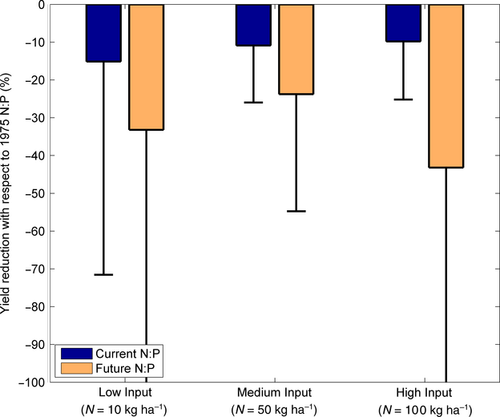
The simulated maize yields at current N : P application ratios, using the EPIC crop model, are displayed in Fig. 4. In the low, medium, and high N-input cases, the mean simulated yields equal 1.2 ± 0.5, 3.2 ± 1.2, and 5.1 ± 2 ton ha−1, respectively, averaged over all harvested grid cells (1.3, 3.4, and 5.6 ton ha−1, respectively, when weighted according to the harvested area in each grid cell). The magnitude of the yields simulated at low N inputs is comparable to the yields currently realized in Africa (cf. Fig. 2 and see evaluation of model performance in (Folberth et al., 2012). Areas limited by water availability can be inferred from the spatial distribution of low simulated yields at high N input (Fig. 4). These water-limited areas are at the fringe of the Sahara, in Southern Africa, including the Kalahari desert, and areas in the Horn of Africa (Fig. 4). The EPIC crop model simulations indicate yield reductions of similar magnitude as the crop trial response functions with current N : P consumption ratios at the continental scale. At low inputs, the weighted continental average is 16% lower than with the ‘past’ N : P ratio, and 7% and 3% lower at medium and high applications, respectively. However, areas dominated by Ferralsols and high precipitation such as in Madagascar and West Africa show yield deficits amounting to up to −50% at low and −20% at intermediate and high application rates (data not shown) in the EPIC model runs.
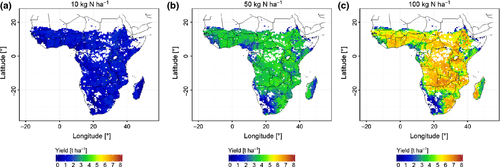
Compared to the 1970s reference period (1975) with an N : P ratio of 1 : 0.29, the relative yield reduction (%) as simulated with the EPIC crop model assuming a future N : P ratio of 1 : 0.05 is shown in Fig. 5 for the low (5a), medium (5b), and high (5c) N-application rates (respectively 10, 50, and 100 kg N ha−1). In the future, at N : P ratios of 1 : 0.05 large yield reductions become evident (Fig. 5). Yet, the EPIC simulations indicate a large spatial heterogeneity in the yield reduction due to increasing N : P ratios across the continent ranging from about 5% to more than 50%. The modeled relative yield deficit reductions are lowest at low yields, but losses can amount to 60% at higher fertilizer application rates. Largest yield reductions are modeled in, e.g., Angola, Madagascar, and several nations in West Africa. The relative impact across all application rates is lower in drier areas, where water availability is the primary factor limiting yields, irrespective of P shortage.
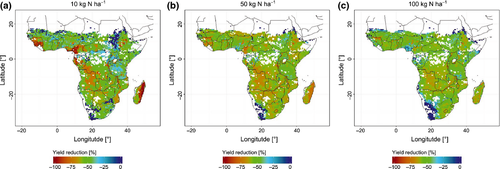
Importance of soil fertility
Soil nutrient management tailored to specific soil types differing in their degree of agronomic suitability is crucial to optimize nutrient use efficiency and thereby minimize crop yield deficits. Crop yield deficits are generally higher for soils with lower agronomic suitability. This is especially apparent in Central Africa where a large fraction of weathered nutrient-poor and P-adsorbing soils such as Ferralsols occurs (see soil map in Fig. 6). In contrast to low application rates, at higher P-application rates, soils with a high P-sorption capacity will be saturated more quickly, thus increasing P availability for plant growth and yield. The soil type-specific reductions in yield associated with a very high future N : P ratio (1 : 0.05) and with the N : P ratio of the 1970s, are shown in Fig. 6 for N-application rates of 10, 50, and 100 kg N ha−1. The crop yield deficit is strongly variable across different soil types. Dominant low-quality soils such as Ferralsols and Arenosols with 21.8% and 16.9% of grid cell coverage (28% of total African maize cropland area) show a strong yield decline for these two types of soils, although there is more spatial variability for Arenosols at low application rates. Ferralsols strongly adsorb P and Arenosols are sandy with low nutrient retention (Table 2).
| Soil type | Grid cell coverage (%) | Current N : P | Future N : P | ||||
|---|---|---|---|---|---|---|---|
| Low Input | Medium | High | Low Input | Medium | High | ||
| Acrisols | 3.30% | −23.22 | −11.63 | −5.70 | −49.58 | −59.96 | −59.42 |
| Arenosols | 21.80% | 0.00 | −4.99 | −0.01 | −26.07 | −56.99 | −52.08 |
| Cambisols | 3.70% | −24.96 | −8.36 | −1.24 | −58.86 | −62.89 | −57.67 |
| Ferralsols | 16.90% | −12.97 | −5.42 | −1.42 | −40.73 | −54.77 | −53.78 |
| Fluvisols | 2.00% | −19.15 | −6.63 | −1.81 | −41.99 | −54.43 | −54.69 |
| Gleysols | 2.30% | −17.13 | −7.49 | −1.38 | −42.63 | −55.75 | −53.28 |
| Lithosols | 8.70% | −16.60 | −5.99 | −1.43 | −40.88 | −53.84 | −52.92 |
| Luvisols | 10.00% | −22.90 | −8.05 | −2.38 | −44.02 | −54.84 | −55.31 |
| Nitosols | 4.70% | −12.95 | −3.48 | −0.81 | −37.40 | −52.12 | −53.24 |
| Planosols | 5.00% | −17.30 | −8.57 | −3.75 | −41.74 | −55.33 | −55.85 |
| Regosols | 5.60% | 0.00 | 0.00 | 0.00 | 0.00 | −42.15 | −45.14 |
| Vertisols | 3.90% | −25.75 | −11.03 | −5.20 | −46.88 | −57.32 | −57.09 |
| Xerosols | 4.50% | −2.93 | −1.75 | −0.18 | −6.48 | −15.94 | −22.02 |
| Yermosols | 6.70% | −25.23 | −10.12 | −5.26 | −50.54 | −59.48 | −60.64 |
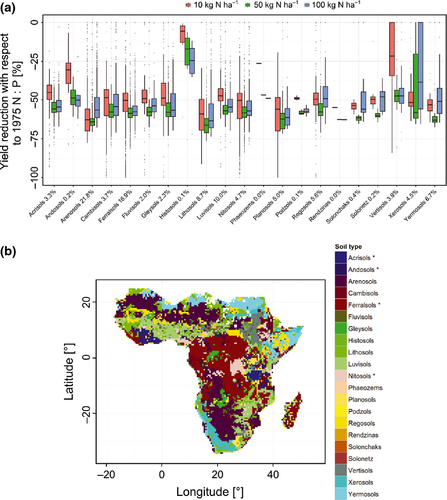
Implications for nutrient use efficiency
We finally estimate optimal ratios (see Data and Methods) defining the lowest amount of applied P at which the highest yield is maintained. The resulting spatial distribution of optimal N : P ratios shown in Fig. 7 indicates lower optimal N : P ratios (i.e. relatively higher P applications at the same N application) at low N-application rates. Balanced applications of N and P are thus relatively more important at low N inputs. Regions where P is strongly limited are those with a typical optimal N : P ratio as low as 1 : 0.6 (i.e. the highest yield was only obtained with a ratio of 1 : 0.6, indicating a high P requirement to achieve a high yield). At the low N-application levels, the lowest optimal N : P ratios are found in Central Africa (Fig. 7a) which is dominated by Ferralsols and Arenosols. At the high N-application level (Fig. 7c), the highest obtainable yields are usually reached for optimal ratios of 1 : 0.1–1 : 0.2, except for maize grown on Ferralsols (Fig. 6). When using the same N : P ratio at higher N-application rates (e.g., 100 kg N ha−1; 10 kg P ha−1), more P will be available to the crop, in particular where soils only have a limited P-sorption capacity. Conversely, if the soil is strongly P adsorbing, a higher ratio will be necessary. In the EPIC model, the optimal N : P ratio required by the maize plant equates to ca. 1 : 0.14. Therefore, if the applied P is readily available in the soil (not sorbed), an N : P ratio of 1 : 0.2 will generally be sufficient to achieve high yields. At the same time, in grid cells where the highest yield is already obtained at an N : P of 1 : 0.1, it may be that N leaching or gaseous N losses are quite strong leading to a lower availability of applied N and hence a smaller P requirement.

Discussion
Soil and nutrient management
The global spatial imbalance of fertilizer consumption and the lack of fertilizer in large parts of the developing world, particularly Africa, are thus compounded by an increasingly unsustainable regional nutrient consumption ratio.
Intensifying agriculture in Africa to meet the demand of an increasing population will have to address three challenges in relation to soil and nutrient management. First, nutrient inputs will need to be increased; second, soils degraded by nutrient mining will have to be restored; and third, nutrient applications of N and P need to be stoichiometrically balanced.
Although an overall increasing trend of N to P ratio is observed in fertilizer statistical data, regional trends are variable. For instance, although we assumed spatially uniform N : P ratios of fertilizer application across Africa, in reality different N : P ratios for maize have been reported in different countries. South Africa reported an N : P ratio applied to maize of 1 : 0.55 in 2004, while Zimbabwe reported a ratio of 1 : 0.14 in 1998. This means that the onset of negative impacts of high N : P ratios on crop yield will vary from nation to nation, and from soil type to soil type, depending on past nutrient management and soil properties, as well as farmer income. In Africa, this threshold has already been exceeded in many soils, as evidenced by the crop trials (Fig. 3). If the current trends are not reversed, the area of impacted cropland will expand over the coming decades. Inefficient applications of N are also an issue, especially in the humid regions of Central Africa. Here, a combination of weathered soils with high N leaching and N emission potential due to high mean annual precipitation, leads to low N use efficiency as a large portion of the applied N is lost from the soil profile.
Reasons for exclusive applications with N may be related to easier supply and access, cheaper fertilizer prices, or traditions. For instance, farmers with limited financial resources, or insecure land tenure agreements, are likely to purchase attractively priced N-urea over more expensive NPK fertilizer mixtures. This may work in the short term but can be detrimental in the longer term, when balanced crop nutrition will become essential to sustain economic benefit (Fig. 7).
Soil types and past management determine when critical N : P thresholds are passed. In the long term, even at low N-application rates, exclusive applications of N lead to asymmetrical soil nutrient status (Van der Velde et al., 2012), and thus to yield deficits. The spatial pattern of optimal N : P ratios is governed by a combination of soil type and climate. Caution has to be taken when attributing the effects of the imbalance in nutrients to soil characteristics as these dynamics are governed by the interplay with climatically driven variables. Nevertheless, one-sided N applications can lead to loss of crop yield and quality over time, negating the initial economic benefits (Van der Velde et al., 2013). If single N applications are continued over longer time periods, this will lead to a selective uptake of other essential crop growth nutrients. Depletion of soil nutrients without replenishment leads to a vicious cycle of insufficient food production, malnutrition, and hunger (Lal, 2010). Poverty drains the soil's fertility and through this vicious cycle reinforces itself.
While we have focused on chemical N and P in this study, we acknowledge that maintaining soil fertility requires a broader approach. Therefore, we emphasize the importance of integrated soil fertility management (Vanlauwe et al., 2011) which includes the use of crop rotations with legumes; the combined application of organic and inorganic fertilizer and improved organic matter management; and the use of improved crop varieties; as well as recognizing the role of other nutrients and micronutrients to sustain crop growth. Indeed, in smallholder farming systems in tropical Africa, the use of organic material as a source of P can improve P availability and maize yields substantially (Kwabiah et al., 2003).
Increased P addition needs to be implemented as early as possible, before detrimentally low N : P availability spreads to even larger areas. Efficient recycling of nutrients, especially of P, will become a necessity. Measures proposed to increase the availability of P often involve increasing the pH of soils (such as liming). Resulting P mobilization may temporarily offset P supply problems, but in the long term, mined soil nutrients need to be replaced. Generally, the links between nutrient-depleted agricultural fields (P-sources) and villages and cities (P-sinks) need to be strengthened (Vitousek et al., 2009), and local nutrient cycles (e.g., sanitation) need to be closed. Importantly, extensive livestock-based systems effectively transfer soil P from grasslands to croplands through the use of manure (cf. ‘the myth of manure’ in (Schlesinger, 2000). Replenishing African pasturelands with P may therefore become a future necessity.
Restoring a balance between agricultural N and P consumption will be an essential task to sustain and even increase global food production. Although global agronomic inputs of P exceed removals of P, P deficits occur across 30% of the world's cropland area (MacDonald et al., 2011). In fact, North America, Western Europe, and East and South Asia accounted for over 80% of global P-fertilizer use, despite comprising less than 55% of global cropland (Sattari et al., 2012). Restoring this balance will require location-specific solutions.
Given the optimal N : P ratio (Fig. 7), we estimate the total additional P required at African level given current N inputs, and given N inputs that would allow Africa to close yield gaps to a reasonable agree (ca. 70%). This is a simplified estimate, only accounting for the numbers calculated in reference to maize, and keeping everything else (e.g., total N consumption) proportional. Current (2010) African consumption of N equals 3192 × 103 tons yr−1, currently consumed P equals 424 × 103 tons yr−1, resulting in an N : P ratio of 1 : 0.13. The optimal N : P ratio as continental level (cf. Fig. 7) at low N inputs equaled 1 : 0.31 (and 1 : 0.23 and 1 : 0.21 for, respectively, the medium and high N inputs) resulting in a P requirement of 989 × 103 tons, yr−1 or an 2.3-fold increase. By comparing current African N inputs which we estimate at 20 kg N ha−1 yr−1, compared to rates of 100 kg N ha−1 yr−1 needed to close yield gaps to a reasonable degree (Folberth et al., 2013), we estimate that N inputs need to increase 5-fold. Increasing N consumption 5-fold will need a P requirement of 4947 × 103 tons yr−1, an 11.7-fold increase, or an additional 4523 × 103 tons yr−1. Taking the total cereal harvested area (an underestimation with respect to total cropped area) at 9.0 107 ha, this would translate to P application rates of 25.9 kg P ha−1 yr−1 (compared to ca. 2.2 kg P ha−1 yr−1 for the current decade), and these inputs will have to be sustained to restore soil fertility. Contrasting these amounts of required P with current (2010) consumption rates in North America, Latin America and the Caribbean, East Asia, Western and Central Europe, of respectively 2038 × 103 tons yr−1, 2229 × 103, 6277 × 103 tons yr−1 and 1115 × 103 tons yr−1, we find that this demand would provide a significant additional pressure on the current extraction of P resources. At very low absolute N-application rates (e.g., 10 kg N ha−1; 1 kg P ha−1), a large fraction of the P might be adsorbed in the soil, thus being inaccessible for plant uptake. Low yielding areas such as in Western Cameroon and the highlands of Madagascar (Folberth et al., 2013) thus require relatively high P application rates because these regions are dominated by Ferralsols and Acrisols with a high P-sorption capacity (Bationo et al., 2007). Also Sierra Leone, with fairly low potential yields and high P application rates, has a mixture of Ferralsols and Acrisols. Andosols are another soil type notorious for high P fixation potentials. High N : P ratios are often sufficient in the Kalahari and Sahel since overall nutrients requirements are low and water is the main yield-limiting factor.
Role of weather and climate change impacts
One important reason for the low fertilizer investments in Africa, especially in those areas that are exposed to drought, is the risk involved when investing into more costly and more efficient fertilizers with a lower N : P ratio. For smallholders with limited financial means this logically results in risk-avoiding behavior as expected losses cannot be compensated for through financial means. Understanding this socio-economic dynamic coupled with the N : P ratios of fertilizers will be critical if the use of lower N : P ratio fertilizers is implemented in regions where they are needed more to increase/maintain yields. This will have to be sustained by a combination of better-tailored climate and weather information. The literature on climate change impacts indicates that agricultural productivity in Africa is threatened. A recent meta-analysis suggested that crop yields will decrease by 8%, although projections by different methodologies varied substantially (Knox et al., 2012) while a review of 20 climate change impact assessments by (Müller et al., 2011) supports the finding in the IPCC Fourth Assessment Report that there will likely be negative effects from climate change on agriculture in Africa. However, when attributing impacts on crop yields, it is important to distinguish between effects that arise from trend changes in yields, those that arise from climate variability (e.g., devastating droughts), and those that arise from shortages and imbalances in applied nutrients and water. Although losses due to suboptimal N : P ratios have occurred, future losses will likely increase due to limited P availability, and continuing depletion of soil P reserves. The impacts we have quantified here suggest significant reductions in future crop yields (>40%) if the current trends in the increasing imbalance of N and P applications are not reversed. Importantly, crop yield losses experienced due to nutrient constraints will be compounded by climate change impacts in large areas of Africa.




